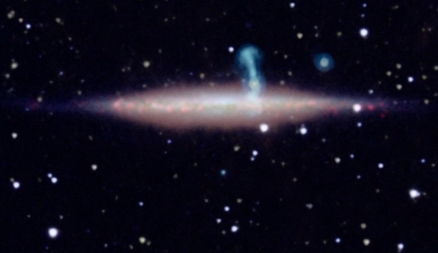Surprising image leads to discovery of a new galaxy
November 14, 2013
Share
By Anne Craig, Communications Officer
Queen’s University professor and principal investigator Judith Irwin (Physics) and a team of astronomers studying gas halos around nearby galaxies were surprised when detailed studies with the National Science Foundation's Karl G. Jansky Very Large Array (VLA) showed that one of their subjects is not a single galaxy, but rather two, nearly perfectly superimposed on the sky to masquerade as one.
 The galaxy UGC 10288 (horizontal) appeared to be a single object in previous radio telescope observations. However new data reveals the large vertical extension is really a distant background galaxy.
The galaxy UGC 10288 (horizontal) appeared to be a single object in previous radio telescope observations. However new data reveals the large vertical extension is really a distant background galaxy.As part of a study of 35 galaxies, the astronomers, including Dr. Irwin, observed one called UGC 10288, a spiral galaxy more than 100 million light-years away. Their multiple VLA observations in 2011 and 2012 produced the best radio-telescope images of that galaxy ever made. The detailed images surprisingly revealed a more-distant galaxy, with strong radio emission, almost directly behind UGC 10288. In previous images, the two galaxies had been blended together.
“This changed the picture, quite literally,” says Dr. Irwin, who initiated the project. “It changed our understanding of the characteristics of the galaxy UGC 10288, but also gave us an unexpected new tool for learning more about that galaxy.”
The background galaxy, which is nearly 7 billion light-years from Earth, and the fact that it is aligned with its radio jets perpendicular to UGC 10288's disk, provides a valuable means of studying the nearer galaxy. Astronomers can use the radio waves from the background galaxy, coming through the nearer one, as a way to measure the properties of the nearer galaxy.
“We're getting a nice scientific reward from the unexpected discovery of the background galaxy,” says Dr. Irwin. “Ironically, we would not have included UGC 10288 in our original study if its radio brightness had not been boosted by the background galaxy in the earlier images.”
Dr. Irwin and co-researcher Jayanne English (University of Manitoba) worked with an international team of astronomers from North America, Europe, and India who are part of the Continuum Halos in Nearby Galaxies - an EVLA Survey (CHANG-ES) consortium.
The scientists reported their findings in the Astronomical Journal.